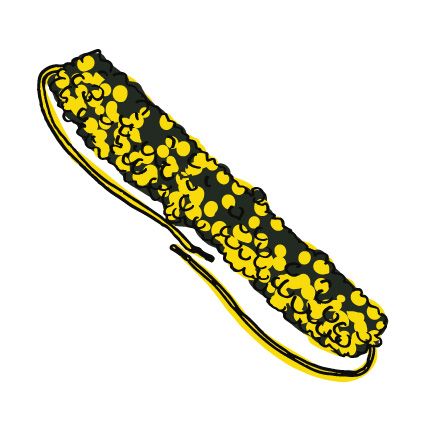
Az általam választott tárgy egy dudari lelet. Rainer Pál ásta 1999-ben. Az in situ felvett fejviselet koponyával együtt került be a restaurátor-műhelybe. Valamennyi antropológiát tanultunk az egyetemen, de itt arra a tudásra sem volt szükségem, hogy lássam – a fogváltás időszakából kikövetkeztetve –, ez egy 7-8 éves lányka pártája. A saját gyermekem akkor pont ennyi idős volt, talán ezért is érintett olyan mélyen, átérezve a szülők fájdalmát.
A lelet magas réztartalmú fémfonalakból és drótokból aprólékos munkával készített, gyöngyös, bogláros pártája selyemszövetre varrt díszítményeinek helyreállításához részben ötvösmunkára volt szükség.
Korábban az akkori osztályvezető, Koncz Pál egyszer arról kérdezett, melyik anyaggal nem szeretek dolgozni a textilrestaurálás során. Mondtam neki hogy a fémekkel. Ő azt válaszolta, hogy akkor az nekem egyszer még nagyon nagy szerelem lesz. Mint sok minden másban, ebben is igaza lett. Beleszerettem az arannyal, ezüsttel, színes selyemmel kivarrt úrihímzésekbe, kézzel készített fémfonalas csipkék, főkötők, hajhálók, gombok, paszományok és viseletkiegészítők változatos, aprólékos világába.
A 18. századi pártát több másik, régebbi fejviselet (Nemesvita, Pápa, Veszprém, Sztána és Kőszeg településekről) rekonstrukciója követte. Legutóbb a Laczkó Dezső 1903-as, Benedek-hegyi feltárásából származó, szintén 7-8 év körüli lányka pártájáé.
Egervári Márta
restaurátor
Erre haladjon tovább:
A sarokban lévő polcon nézzünk bele a kukucskálódobozba, valamint olvassuk is le a fölötte lévő kódot! Egy ismeretlen világba fogunk csöppenni! (A képek az irodából már ismerősek lehetnek)
The item I chose is an artifact from Dudar, excavated by Pál Rainer in 1999. The item arrived at the restoration workshop in situ, still attached to the skull it was found on.. We learned some anthropology in university, but even that knowledge was not needed to determine - based on the fact that the individual was losing baby teeth - that this párta belonged to a girl of 7-8 years of age. My own child was the same age around this time, maybe that was the reason why I was deeply touched, understanding the pain of the girl's parents.
The restoration involved meticulously crafted beaded and gilded headdress decorations, sewn on silk cloth and made from high-copper-content metal threads and wires, requiring delicate metalwork
Pál Koncz, who was the head of department at the time, asked me once about which materials I don’t like to work with during textile restoration. I told him that metals are the one. In turn he replied that they will be my greatest passion one day. Just like with many other things, he was right about this too. I fell in love with the diverse and intricate world of working with noble embroidery adorned with gold, silver and colorful silk, as well as the handmade metallic lace, bonnets, hair nets, buttons, braids and other clothing accessories.
The 18th century párta was followed by the restoration of many other, older headdresses( from Nemesvita, Pápa, Veszprém, Sztána and Kőszeg). The latest was the párta of the seven or eight years old girl, that was found during the excavation by the Laczkó Dezső Museum on Benedek-hill in Veszprém.
Márta Egervári
restorer
Proceed to this:
Let us continue. Take a look inside the peep box that is on the corner shelf, and scan the code above it! We will find ourselves in an unknown world! (The pictures from the office might be familiar already)